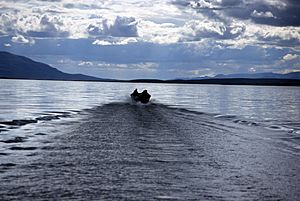Unalakleet River facts for kids
Quick facts for kids Unalakleet River |
|
|---|---|

Boat on Unalakleet River
|
|
|
Location of the mouth of the Unalakleet River in Alaska
|
|
| Country | United States |
| State | Alaska |
| Census Area | Yukon–Koyukuk, Nome |
| Physical characteristics | |
| Main source | Kaltag Mountains Yukon–Koyukuk Census Area 2,329 ft (710 m) 64°20′27″N 159°12′12″W / 64.34083°N 159.20333°W |
| River mouth | Norton Sound Near Unalakleet, Nome Census Area 3 ft (0.91 m) 63°52′10″N 160°47′16″W / 63.86944°N 160.78778°W |
| Length | 90 mi (140 km) |
| Type: | Wild |
| Designated: | December 2, 1980 |
The Unalakleet River is a beautiful river in Alaska, a state in the United States. It flows about 90 miles (145 km) from the Kaltag Mountains. The river ends near the town of Unalakleet, where it meets Norton Sound in the Bering Sea.
A large part of the river, about 80 miles (129 km), is protected. In 1980, it became a "wild" river. This means it's part of the National Wild and Scenic Rivers System. The Bureau of Land Management helps take care of this special part of the river.
Fun Activities on the River
The Unalakleet River is a great place for many activities. People love to fish here for different types of salmon. You can find king salmon and silver salmon. Other fish like Arctic grayling and char also live in the river.
During the warmer months, you can go boating and camping along the river. When winter arrives, the river freezes over. This makes it perfect for snowmobiling and dog mushing. People also enjoy ice fishing, hunting, and trapping in the winter. Part of the famous Iditarod Trail even follows the Unalakleet River.
River History
The name "Unalakleet" comes from the Inupiat language. It means "place where the east wind blows." For a long time, this river was an important path. It connected people living on the coast to those living inland along the Yukon River. This route, which included the Kaltag Portage, was the shortest way between the Yukon River and Norton Sound.
Eskimo people have lived near the Unalakleet River for many hundreds of years. Some old house pits found in the area are from as far back as 200 B.C. In the 1830s, the Russian-American Company set up trading posts. These were in places like St. Michael and Unalakleet. A Russian naval officer named Lieutenant Lavrenty Zagoskin wrote the first reports about the Unalakleet River from a non-native perspective.
Later, in 1898, people from Lapland came to the river. They started raising reindeer herds there. Soon after, gold seekers traveled through the area. They were looking for gold on the nearby Seward Peninsula. They used the Kaltag Portage and then went down the river to the coast. Over time, more changes came to the river area. A telegraph line was built with cabins along the river. A mail route was also set up, making it easier to send letters.


